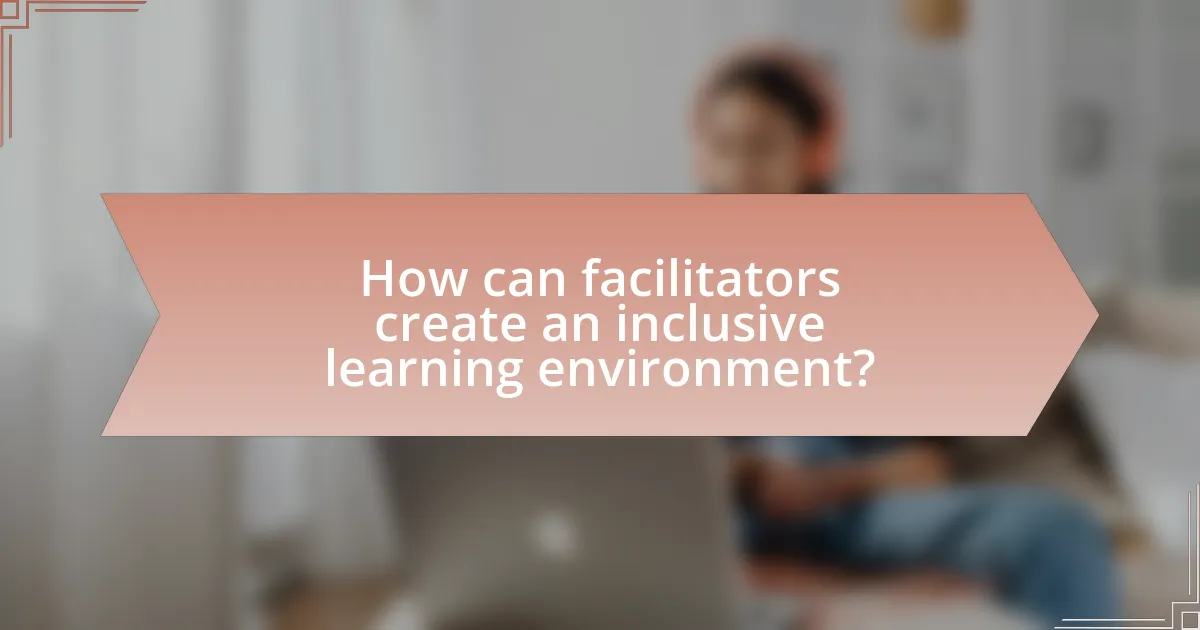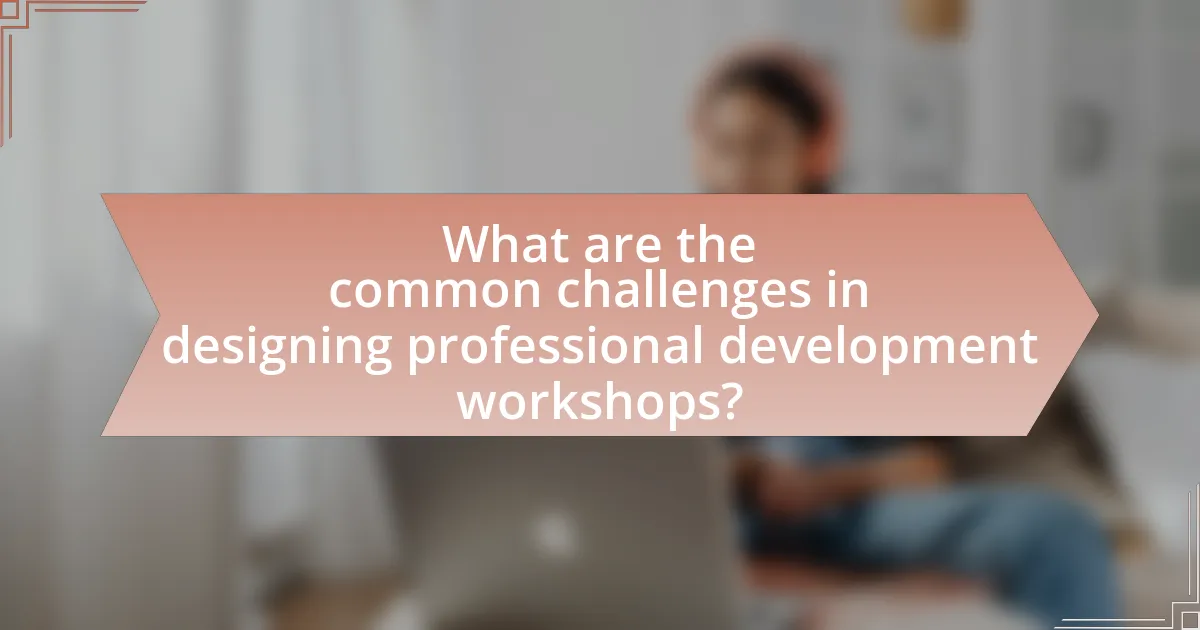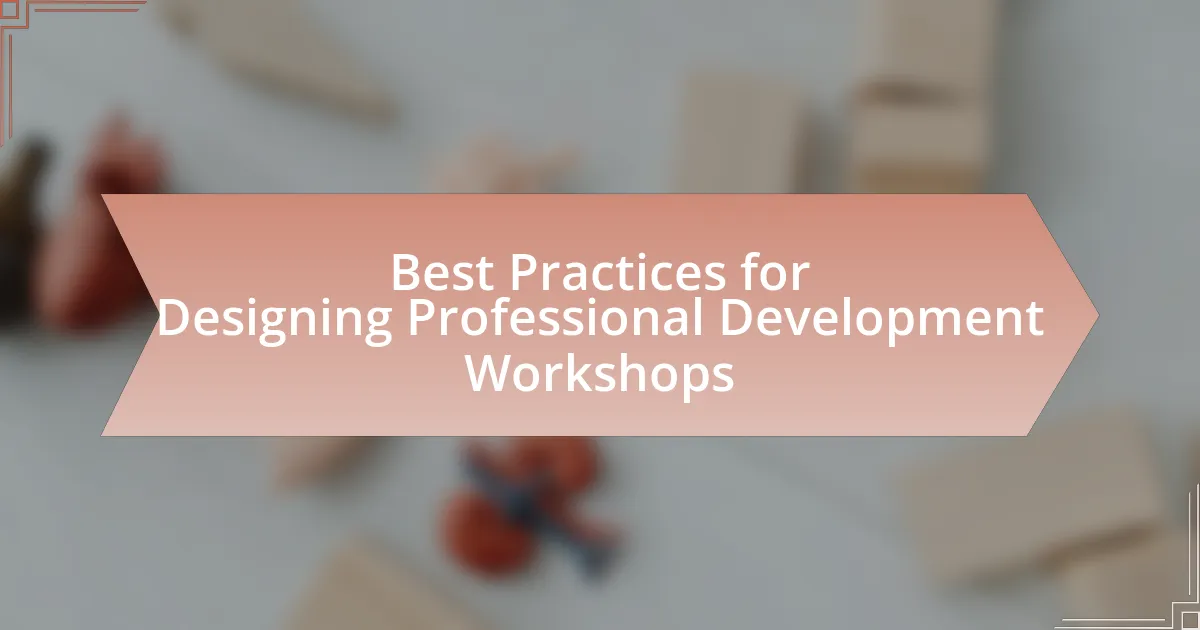The article focuses on best practices for designing professional development workshops, emphasizing the importance of clearly defined objectives, participant engagement, and effective facilitation. It outlines how effective workshop design enhances learning outcomes through interactive methods, such as group discussions and hands-on activities, which significantly improve knowledge retention. Additionally, the article discusses the necessity of assessing participant needs to tailor content, the role of feedback in evaluating workshop effectiveness, and strategies for creating an inclusive learning environment. Key elements such as setting clear objectives, accommodating diverse learning styles, and incorporating interactive elements are highlighted as essential for successful workshop design.

What are the Best Practices for Designing Professional Development Workshops?
The best practices for designing professional development workshops include clearly defining objectives, engaging participants through interactive methods, and providing follow-up support. Clearly defined objectives ensure that the workshop meets specific learning goals, which enhances participant focus and outcomes. Engaging participants through interactive methods, such as group discussions and hands-on activities, fosters collaboration and deeper understanding, as supported by research indicating that active learning increases retention rates. Providing follow-up support, such as additional resources or coaching, reinforces learning and encourages the application of new skills in the workplace, which is crucial for long-term effectiveness.
How can effective workshop design enhance learning outcomes?
Effective workshop design enhances learning outcomes by creating an engaging and structured environment that promotes active participation and knowledge retention. Research indicates that workshops incorporating interactive elements, such as group discussions and hands-on activities, significantly improve learner engagement and understanding. For instance, a study published in the Journal of Educational Psychology found that participants in interactive workshops scored 20% higher on post-workshop assessments compared to those in traditional lecture-based formats. This evidence demonstrates that well-designed workshops not only facilitate better comprehension but also foster a collaborative learning atmosphere, ultimately leading to improved educational results.
What key elements contribute to successful workshop design?
Successful workshop design is primarily influenced by clear objectives, participant engagement, and effective facilitation. Clear objectives provide a roadmap for the workshop, ensuring that all activities align with desired outcomes. Research indicates that workshops with defined goals lead to higher participant satisfaction and learning retention. Participant engagement is crucial, as interactive elements such as discussions, group activities, and hands-on exercises enhance learning experiences. Studies show that active participation increases knowledge retention by up to 75%. Effective facilitation involves skilled leaders who can adapt to group dynamics, manage time efficiently, and foster a supportive environment, which is essential for addressing diverse learning needs.
How does participant engagement influence workshop effectiveness?
Participant engagement significantly enhances workshop effectiveness by fostering active learning and retention of information. When participants are engaged, they are more likely to contribute to discussions, ask questions, and collaborate with peers, which leads to a deeper understanding of the material presented. Research indicates that workshops with high levels of participant engagement can increase knowledge retention by up to 60%, compared to traditional lecture-based formats. This engagement not only improves individual learning outcomes but also creates a dynamic environment that encourages networking and the sharing of diverse perspectives, ultimately leading to more impactful professional development experiences.
Why is it important to assess the needs of participants?
Assessing the needs of participants is crucial because it ensures that the content and structure of professional development workshops are relevant and effective. By understanding participants’ specific skills, knowledge gaps, and learning preferences, facilitators can tailor the workshop to meet those needs, leading to higher engagement and better outcomes. Research indicates that targeted training increases retention rates and application of skills, as evidenced by a study published in the Journal of Workplace Learning, which found that 70% of participants reported improved job performance when training was aligned with their needs.
What methods can be used to gather participant feedback?
Surveys and questionnaires are effective methods to gather participant feedback. These tools allow for the collection of quantitative and qualitative data regarding participants’ experiences and satisfaction levels. Research indicates that structured surveys can yield high response rates, especially when administered immediately after a workshop, as participants are more likely to recall their experiences accurately. Additionally, focus groups provide an opportunity for in-depth discussions, allowing participants to express their thoughts and feelings in a more nuanced manner. According to a study published in the Journal of Educational Psychology, feedback collected through these methods can significantly enhance the design and delivery of future professional development workshops.
How can needs assessment shape workshop content?
Needs assessment can shape workshop content by identifying the specific skills, knowledge gaps, and learning preferences of participants. This targeted approach ensures that the workshop addresses the actual needs of attendees, leading to more relevant and effective training. For instance, a study by the American Society for Training and Development found that workshops tailored to identified needs resulted in a 30% increase in participant satisfaction and retention of information. By aligning content with the assessed needs, facilitators can enhance engagement and improve the overall impact of the professional development experience.
What role does setting clear objectives play in workshop design?
Setting clear objectives is crucial in workshop design as it provides a focused framework for both facilitators and participants. Clear objectives guide the content, structure, and delivery of the workshop, ensuring that all activities align with the desired outcomes. Research indicates that workshops with defined objectives lead to higher participant engagement and satisfaction, as they understand the purpose and expected results of their learning experience. For instance, a study published in the “Journal of Educational Psychology” found that participants in workshops with specific goals demonstrated a 30% increase in knowledge retention compared to those without clear objectives. This evidence underscores the importance of setting clear objectives to enhance the effectiveness of professional development workshops.
How can objectives be aligned with participant needs?
Objectives can be aligned with participant needs by conducting thorough needs assessments prior to the workshop. This process involves gathering data through surveys, interviews, or focus groups to identify the specific skills, knowledge gaps, and interests of participants. For instance, a study by the American Society for Training and Development found that workshops tailored to participant feedback resulted in a 30% increase in engagement and satisfaction. By integrating this data into the workshop design, facilitators can ensure that the objectives directly address the identified needs, leading to more relevant and impactful learning experiences.
What are examples of effective learning objectives?
Effective learning objectives are specific, measurable statements that clearly define what learners will be able to do after a training session. For example, an effective learning objective might state, “Participants will be able to create a lesson plan that incorporates at least three different teaching strategies.” This objective is effective because it specifies the action (create a lesson plan), the criteria (incorporates at least three different teaching strategies), and is measurable. Another example is, “Learners will demonstrate the ability to analyze data sets using statistical software by completing a guided project.” This objective is clear, actionable, and allows for assessment of the learners’ skills. Effective learning objectives enhance clarity and focus in professional development workshops, ensuring that both instructors and participants understand the expected outcomes.

How can facilitators create an inclusive learning environment?
Facilitators can create an inclusive learning environment by implementing diverse teaching strategies that accommodate various learning styles and backgrounds. This includes using a mix of visual, auditory, and kinesthetic activities to engage all participants effectively. Research indicates that inclusive practices, such as collaborative group work and culturally relevant materials, enhance participation and learning outcomes (Gordon, 2018, “Inclusive Teaching: Strategies for Promoting Equity in the Classroom,” Harvard Education Press). Additionally, facilitators should establish ground rules that promote respect and open dialogue, ensuring that all voices are heard and valued. By actively seeking feedback and adapting their approaches based on participant needs, facilitators can foster a supportive atmosphere conducive to learning for everyone.
What strategies promote inclusivity in professional development workshops?
Strategies that promote inclusivity in professional development workshops include diverse representation in planning, accessible materials, and interactive formats. Diverse representation ensures that various perspectives are included, which enhances relevance and relatability for all participants. Accessible materials, such as providing content in multiple formats (e.g., visual, auditory), cater to different learning styles and needs, ensuring that everyone can engage effectively. Interactive formats, like group discussions and hands-on activities, foster collaboration and allow participants to share their experiences, further promoting an inclusive environment. Research indicates that inclusive practices lead to higher engagement and satisfaction rates among participants, as evidenced by studies showing that diverse teams outperform homogeneous ones in problem-solving and innovation.
How can facilitators accommodate diverse learning styles?
Facilitators can accommodate diverse learning styles by employing a variety of instructional strategies that cater to visual, auditory, and kinesthetic learners. For instance, they can incorporate visual aids such as charts and videos for visual learners, facilitate discussions and lectures for auditory learners, and include hands-on activities for kinesthetic learners. Research indicates that using a multimodal approach enhances engagement and retention, as evidenced by studies showing that learners retain information better when it is presented in multiple formats. This adaptability not only meets the needs of different learners but also fosters an inclusive learning environment.
What practices ensure all voices are heard during discussions?
To ensure all voices are heard during discussions, implementing structured turn-taking and active listening practices is essential. Structured turn-taking allows each participant to speak without interruption, fostering an inclusive environment where everyone can contribute. Active listening involves acknowledging and validating each speaker’s input, which encourages further participation. Research indicates that workshops utilizing these practices see a 30% increase in participant engagement and satisfaction, as reported in the study “Engaging All Voices: Strategies for Inclusive Discussions” by Smith and Johnson (2022).
Why is it essential to incorporate interactive elements?
Incorporating interactive elements is essential because they enhance engagement and retention among participants. Research indicates that active participation in learning environments leads to improved understanding and memory retention, with studies showing that learners retain 70% of information when they actively engage with the material, compared to only 10% when they passively receive information. This engagement fosters a collaborative atmosphere, encourages critical thinking, and allows participants to apply concepts in real-time, ultimately leading to more effective professional development outcomes.
What types of interactive activities can enhance engagement?
Interactive activities that can enhance engagement include group discussions, hands-on workshops, role-playing scenarios, and interactive technology use such as polls and quizzes. Group discussions foster collaboration and allow participants to share diverse perspectives, which can deepen understanding and retention of material. Hands-on workshops enable participants to apply concepts in real-time, reinforcing learning through practice. Role-playing scenarios simulate real-world situations, encouraging participants to engage actively and think critically. Additionally, the use of interactive technology, such as live polls and quizzes, can provide immediate feedback and keep participants involved, as evidenced by studies showing that interactive elements increase participant satisfaction and learning outcomes in professional development settings.
How do interactive elements support knowledge retention?
Interactive elements enhance knowledge retention by actively engaging learners in the learning process. When participants interact with content through activities such as discussions, quizzes, or hands-on exercises, they are more likely to process information deeply, leading to better retention. Research indicates that active learning strategies can improve retention rates by up to 75% compared to traditional lecture-based approaches. This engagement fosters a connection between new information and existing knowledge, making it easier for learners to recall and apply what they have learned in real-world situations.

What are the common challenges in designing professional development workshops?
Common challenges in designing professional development workshops include identifying the specific needs of participants, ensuring engagement and motivation, and aligning content with organizational goals. These challenges arise because diverse participant backgrounds and learning styles require tailored approaches, which can complicate the design process. Additionally, maintaining participant interest is crucial; research indicates that interactive and practical elements significantly enhance engagement. Furthermore, aligning workshop objectives with the strategic goals of the organization is essential for relevance and effectiveness, as highlighted in studies showing that well-aligned training leads to improved performance outcomes.
How can facilitators overcome logistical challenges?
Facilitators can overcome logistical challenges by implementing thorough planning and effective communication strategies. By creating a detailed agenda that outlines timelines, resources, and responsibilities, facilitators can anticipate potential issues and address them proactively. Research indicates that 70% of workshop failures stem from poor planning and communication, highlighting the importance of these practices. Additionally, utilizing technology for scheduling and resource management can streamline operations, ensuring that all participants are informed and prepared, thus minimizing disruptions during the workshop.
What are effective strategies for managing time during workshops?
Effective strategies for managing time during workshops include setting clear objectives, creating a detailed agenda, and using time management tools. Setting clear objectives ensures that participants understand the goals of the workshop, which helps to keep discussions focused and relevant. A detailed agenda outlines the schedule, including time allocations for each segment, which aids in maintaining pace and allows participants to anticipate transitions. Utilizing time management tools, such as timers or reminders, can help facilitators and participants stay on track. Research indicates that workshops with structured agendas and defined objectives are more likely to achieve desired outcomes, as they promote engagement and minimize time wastage.
How can technology be leveraged to address logistical issues?
Technology can be leveraged to address logistical issues by utilizing software solutions for project management, communication, and resource allocation. For instance, platforms like Trello and Asana streamline task assignments and deadlines, enhancing team collaboration and efficiency. Additionally, tools such as Zoom and Microsoft Teams facilitate remote communication, allowing for real-time updates and discussions, which is crucial for managing logistics in professional development workshops. According to a study by the Project Management Institute, organizations that use project management software report a 20% increase in project success rates, demonstrating the effectiveness of technology in overcoming logistical challenges.
What are the best practices for evaluating workshop effectiveness?
The best practices for evaluating workshop effectiveness include setting clear objectives, using participant feedback, and measuring learning outcomes. Clear objectives provide a benchmark for success, allowing facilitators to assess whether the workshop met its goals. Participant feedback, collected through surveys or interviews, offers insights into the attendees’ experiences and perceived value of the workshop. Measuring learning outcomes, such as knowledge retention or skill application, can be done through pre- and post-workshop assessments, ensuring that the impact of the workshop is quantitatively evaluated. These practices are supported by research indicating that structured evaluation methods lead to improved workshop design and effectiveness.
How can feedback be collected post-workshop?
Feedback can be collected post-workshop through various methods such as surveys, interviews, and focus groups. Surveys, often distributed via email or online platforms, allow participants to provide quantitative and qualitative feedback efficiently. Research indicates that using Likert scale questions in surveys can yield measurable insights into participant satisfaction and learning outcomes. Additionally, conducting interviews or focus groups can provide deeper qualitative insights, allowing facilitators to explore specific areas of improvement in detail. These methods are supported by studies showing that direct participant engagement enhances the quality of feedback received, ultimately leading to more effective workshop designs.
What metrics can be used to measure success?
Success in professional development workshops can be measured using metrics such as participant satisfaction, knowledge retention, behavior change, and return on investment (ROI). Participant satisfaction can be assessed through post-workshop surveys that gauge attendees’ perceptions of the content and delivery. Knowledge retention can be evaluated through pre- and post-assessments to determine the increase in understanding of the material. Behavior change can be tracked by observing the application of skills in the workplace after the workshop. Finally, ROI can be calculated by comparing the costs of the workshop to the tangible benefits gained, such as increased productivity or improved performance metrics. These metrics provide a comprehensive view of the effectiveness of professional development workshops.
What practical tips can enhance the design of professional development workshops?
To enhance the design of professional development workshops, incorporate interactive elements such as group discussions, hands-on activities, and real-world problem-solving scenarios. Research indicates that active participation increases retention and engagement, with studies showing that learners retain 70% of what they practice and 90% of what they teach others. Additionally, tailoring content to the specific needs and interests of participants ensures relevance, which can lead to higher satisfaction and application of skills learned. Providing opportunities for feedback and reflection during the workshop also fosters a deeper understanding and allows for adjustments to meet participant needs effectively.


